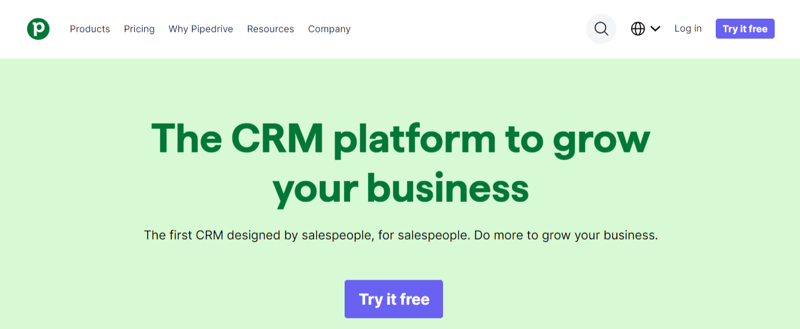
5 Best Pipeline Management Software [2026 Edition]
 Updated on
Updated on
 By Robins Dorvil
By Robins Dorvil
Robins Dorvil
With over 7 years of experience in the insurance industry, 4+ years as an Account Executive at Ringy CRM, and 17 years as a Creative Real Estate Inves...
learn more
Robins Dorvil
With over 7 years of experience in the insurance industry, 4+ years as an Account Executive at Ringy CRM, and 17 years as a Creative Real Estate Inves...
Table of Contents
Table of Contents
Handling multiple sales pipelines without a proper system?
Joy-killer.
But let's focus on the facts.
Businesses with formal sales processes generate more revenue. Like, at least 18% more.
So what's holding you back from investing in the tools that empower your sales team and bump those numbers?
We get it. There's such an overwhelming amount of sales tools out there nowadays. Understanding how they work and which one is better is so confusing. It's no wonder you're putting it off.
We're here to help.
In this article, we'll discuss and compare the best pipeline management software tools to help you evaluate what's best for your business.
But first, a refresher.
What Is Pipeline Management?
Pipeline management means monitoring and proactively managing performance at every stage of the sales process, from the initial interaction to closing the deal. This is achieved with a CRM. By managing their pipeline effectively, sales teams perform more accurately and consistently. They can also use the data gained from this process to improve processes and maximize results.
It's hard to describe pipeline management because it's a sales activity, a skill that a sales rep develops, and the features of a CRM.
With a CRM like Ringy, pipeline management looks like:
- Tracking pipeline metrics to analyze the success of your sales process
- Maintaining CRM ‘hygiene' so leads, notes, and tasks are organized
- Optimizing each stage of your sales process so it works efficiently
- Coaching your sales team, so they're empowered to improve their performance
- Calculating and maximizing revenue at different stages
- Taking advantage of automated and intuitive sales tools to drive performance
By far the most valuable function of pipeline management is the data you can draw from it.
When working well, pipeline management tools give you the visibility to:
- Learn from successful opportunities to close a deal
- Closely track leads to nurture them effectively
- Spot leaks in your pipeline and sales process that need improvement
A pipeline management tool enables you to have an in-depth understanding of your sales pipeline to discover what works, why it works, and how to repeat key moves so you can close more deals.
But it's not just about the wins.
The greatest lessons are learned the hard way, and a pipeline management tool can also help you identify exactly what went wrong with the lost deals.
You can achieve this via detailed reports on individual and team-wide interactions with prospects during your sales cycle.
These reports give sales managers the power to evaluate:
- How accurately your team is qualifying leads
- Whether your messages are effective
It's easy to confuse a sales pipeline with a sales funnel.
While both are important for achieving your sales goals, they look at your customer relationship from different angles:
|
Sales Funnel |
Sales Pipeline |
|
|
Focus point |
The number of prospects converted after each stage |
The stages it takes for a potential customer to become an actual customer |
|
Key metrics |
|
|
Understanding the Sales Pipeline
Understanding the sales pipeline stages is crucial for leveraging these tools effectively. Here's a brief explanation of the stages within a sales pipeline:
- Prospecting: Sales pipeline management tools help track and manage these initial contacts.
- Qualification: The best pipeline management software aids in sorting and prioritizing qualified leads.
- Contact: Sales pipeline tools facilitate seamless interactions through various channels.
- Proposal: A pipeline management tool ensures that proposals are tracked and managed efficiently.
- Negotiation: Sales pipeline management tools keep all communication and negotiation details organized.
- Closing: Sales pipeline management software tracks these final steps to ensure nothing falls through the cracks.
Why Pipeline Management is Crucial for Sales Teams

Managing your pipeline is essential to your business's growth.
72% of sales managers review their sales pipeline with their teams several times per month.
And when 63% of respondents say that their companies do an awful job managing their sales pipelines, it's pretty obvious that using pipeline sales management software is a game-changer.
So, why is tracking your sales pipeline and staying updated on critical metrics so important to improving your sales strategy?
Because if you don't know exactly where your team is at, you won't be able to identify whether you're winning.
After all, the M in “SMART” sales goals is “measurable”.
But don't just take our word for it.
94% of enterprises say that data, analytics, and metrics are essential to the growth of a business.
The best sales pipeline management software enables you to effectively track engagements along your pipeline for streamlined analysis and reporting.
Using a pipeline management tool helps you analyze and optimize every nook and cranny of your sales pipeline, leaving no stone—or lead—unturned.
Let's not forget that we are talking about the best pipeline management software. But you can check out our article that goes in-depth into the key metrics and tips on getting the best out of your sales pipeline management here.
Importance of Tracking Prospects Through Each Stage of the Pipeline
Here's why using pipeline management software and its variations is essential:
- Improved Organization: Sales pipeline management tools help keep all your prospects organized, ensuring that no lead is overlooked or forgotten. By using sales pipeline management software, you can track each prospect's progress and maintain a clear overview of your sales activities.
- Enhanced Efficiency: With pipeline management software, you can streamline your sales process, reducing time spent on manual tracking and allowing your team to focus on closing deals. This efficiency is particularly evident when using the best pipeline management software, which automates routine tasks and provides real-time updates.
- Better Forecasting: Tracking prospects through each stage allows for more accurate sales forecasting. Sales pipeline management tools provide insights into the likelihood of closing deals, helping you predict future revenue and plan accordingly.
- Increased Accountability: Sales managers can easily monitor their team's performance and ensure that everyone is following up with prospects appropriately by using sales pipeline tools. This accountability is vital for maintaining a high standard of sales activities.
- Enhanced Customer Relationships: Pipeline management tools facilitate timely and personalized communication with prospects. By tracking each stage of the sales pipeline, you can provide relevant information and support, ultimately improving customer satisfaction and increasing the chances of closing deals.
Challenges of Pipeline Management
At first, building a sales pipeline might seem like a straightforward process. But, having the right building blocks without good management can result in a good-looking system with many leaks.
Planning for pipeline management challenges will ensure you're ready to overcome them.
So we'll discuss:
- Undefined sales process
- Dead leads
- Not sticking with a sales process schedule.
- Not prioritizing top leads.
Let's get into more detail.
1. Undefined Sales Process
A sales process entails the steps taking a prospect from being a new lead to a paying customer.
These steps include the activities, events, and triggers to move a prospect from one stage to the next. Failing to define these steps or events leaves you unable to communicate the right message to your lead at the right time.
For example, your lead has reached your sales funnel's action stage. They have considered competitors and decided your product is the right solution for their problem.
But rather than striking the iron while it's hot and getting them to close the deal with a one-time offer or discounted prices, you delay by still making introductory calls about your product like they are in the interest stage.
That creates an opportunity for your competitors to steal the prospect away because you failed to sweep them off their feet at the right time.
Then, think about the numerous meetings sales reps have that don't result in any progress. That's because you haven't specified ways your sales reps should guide your prospects through the buying process.
2. Keeping It Clean, Focused, and Flowing
A well-managed sales pipeline is the lifeblood of your sales team's success. However, keeping things clean and focused can be met with the following roadblocks:
- Dead Leads: Unattended leads turn cold, cluttering your pipeline and skewing conversion rates. Pipeline management software helps by identifying and removing these leads, allowing you to focus on qualified prospects.
- Poor Lead Prioritization: Not all leads are created equal. Failing to prioritize high-value prospects wastes valuable time and resources. Pipeline management tools can help you identify and prioritize the leads with the highest closing potential.
Due to these challenges, 83% of companies that don't have a system for prioritizing leads don't achieve the average of their conversion rates.
So, addressing these obstacles can ensure that your pipeline stays clean, focused, and flowing with qualified leads ready to convert into sales.
3. Failing to Follow a Sales Process
Having a cold leads can be challenging enough, but add disorganization to the mix, and it's a disaster for your sales pipeline.
Pipeline management software helps you develop a schedule, but you need to stick to it before you can see results.
Everyone plans, but execution separates the best from the rest.
Here's what failing to stick to your sales process schedule looks like:
- Not measuring pipeline metrics
- Irregular pipeline management meetings
- Zero pipeline maintenance
- A sales pipeline overwhelmed with cold leads
From zero analysis for measuring your sales growth to spontaneous meetings, doing activities without a schedule can negatively impact your sales team's productivity and make you lose more leads.
4. Lack of Visibility
Without clear visibility into your sales pipeline, it's difficult to understand where leads are getting stuck, how long deals are taking to close, and how well your sales team is performing. Pipeline management software provides a centralized view of your pipeline, giving you the insights you need to make informed decisions.
Poor Sales Process Alignment
A disconnect between marketing and sales can wreak havoc on your pipeline. For example, marketing might generate a high volume of unqualified leads and overwhelm your sales team. Pipeline management tools can help improve communication and alignment between marketing and sales, ensuring a steady stream of qualified leads enters your pipeline.
We've got solutions to these challenges in the next section.
Pipeline Management Solutions

Achieving your sales goals means overcoming challenges.
Let's dive into actionable tips you can use with sales pipeline tools to handle your pipeline like a boss.
In the proper order, you can implement these tips with sales management software to optimize your pipeline, shorten your sales cycles and increase the number of opportunities:
- Clarify your sales strategy
- Clear your pipeline
- Develop a pipeline management schedule and stick to it
- Prioritize major leads
Ready?
Clarify Your Sales Strategy
First thing's first. You need a clear and concise sales strategy.
A sales strategy ensures that you lay the necessary groundwork for success by:
- Fine-tuning your sales cycle
- Making it easier for new sales reps to adapt to your sales workflow
- Enhancing team productivity because everyone's tasks are obvious
- Gaining insights into customer engagement, work performance, and future revenue forecasts
The best pipeline software helps you assign straightforward tasks to your sales reps, improve collaboration between team members and maintain good customer relationships with workflow automation and contact management features.
Start with defining clear sales goals and specific roles for sales reps and outlining the tone and voice to interact with prospects in each stage.
Clear Your Pipeline
Cold leads, dead leads, redundant leads.
These leads are the sludge in your pipeline that don't allow your sales process to perform smoothly.
If that isn't a good enough reason to clean your pipeline, there's more. Cleaning your sales pipeline can help you:
- Eliminate redundant data to improve your forecast accuracy
- Avoid mistaking a prospect for a wrong stage in the pipeline
- Stop missing the right time to contact leads
50% aren't a good fit for your product or service, so the earlier you focus on the right ones, the better your sales pipeline.
You can use a sales pipeline management tool to schedule break-up emails to unresponsive prospects to give them the last chance to further their interest in your product before taking them out of your sales pipeline.
Develop a Pipeline Management Schedule and Stick To It
You can do more than knowing the importance of managing your sales pipeline. Develop a pipeline management schedule to optimize your workflow and your resources.
Then it's time for the challenging part: sticking to it.
For starters, you don't need to rush everything, everywhere, and all at once. While it can get unnecessarily overwhelming, it can make you further lose track of what's happening in your pipeline.
Start slowly, then try to space things out so that it can be more convenient for you and your team to adopt and implement into your sales process.
You can start with these tips to establish and follow a pipeline management schedule:
- Have a pipeline management meeting every month – don't forget to keep it short and straight to the point.
- Send that break-up email every three months – say "no" to dead leads.
- Assess your pipeline metrics every week – because you need to consistently keep track of what's going on in your sales pipeline
- Thorough pipeline maintenance every quarter – ensure that everywhere is squeaky clean and working according to your preference and strategy.
Prioritize Major Leads
So, you've assigned specific roles to your team members to ensure your sales strategy is effective. You've cleaned up your pipeline, so it's spotless, and created a pipeline management schedule you can follow.
So, what's next?
Lead prioritization. The essential element that drives your sales revenue.
While you have a better view of qualified leads and the process of converting them to customers, focusing on the more valuable ones will help you hit your bottom line faster.
Converting leads that are a better fit for your customer persona can be more convenient because your product is more likely to be the perfect solution to their problem.
Train your sales reps to spot these leads and prioritize them; you are good to go.
Forecast Sales Accurately
Accurate sales forecasting is crucial for any business. Pipeline management software helps you ditch the guesswork and make data-driven predictions about future revenue. By analyzing the value and stage of deals in your pipeline, you can generate forecasts that are more reliable than ever before. This allows you to:
- Make informed decisions about resource allocation, budgeting, and hiring.
- Predict potential shortfalls and take corrective action before they impact your bottom line.
- Align sales and marketing efforts to ensure you have the right resources in place to meet your sales goals.
Pipeline management tools typically offer features like weighted pipelines and historical sales data analysis to provide the most accurate forecasts possible.
Implement Data Quality Controls
Garbage in, garbage out. The quality of your data is paramount to the effectiveness of your pipeline management strategy. Pipeline management software can help you:
- Standardize data entry: Ensure all reps are using consistent terminology and formats when entering lead information.
- Identify and eliminate duplicate leads: No one wants to waste time nurturing the same lead twice. Pipeline management tools can help you identify and eliminate duplicates, keeping your pipeline clean and streamlined.
- Automate data entry: Integrate your pipeline management software with your CRM system or marketing automation platform to reduce manual data entry. This will free up your sales reps' time to focus on selling, not data entry.
By implementing data quality controls, you can ensure your pipeline reflects a clear and accurate picture of your sales prospects.
Provide Ongoing Training and Support
Even the most powerful pipeline management software won't be effective if your sales team doesn't know how to use it properly. The best pipeline management solutions offer ongoing training and support to ensure your team gets the most out of the platform. This may include:
- User onboarding: Get your team up and running quickly with comprehensive training on the features and functionalities of the software.
- Ongoing webinars and tutorials: Provide ongoing learning opportunities to help your team stay up-to-date on the latest features and best practices.
- Dedicated customer support: Have peace of mind knowing there's someone to help if your team encounters any issues with the software.
Cue drum rolls. Next up is our list of the best pipeline management software.
5 Best Sales Pipeline Management Software
Ringy

“Isn't this your product?”
Yes, it's our baby. And we wouldn't be first if we didn't have the sauce to prove it. After all, it's not bragging if it's true.
Ringy enables you to run drip campaigns to engage and nurture leads at all stages of your sales process. Cold leads are not left out because you can use email and SMS automation to encourage them while you focus on selling.
You can manage your sales pipeline like a boss, from sending the right message at the perfect time to hands-off lead nurturing. Managing multiple sales pipelines doesn't seem daunting; with time, you can see positive growth in your metrics.
More of Ringy's features include:
- Contact management for interacting with prospects via call, text, and email
- Insights and reporting tools to replicate successes of winning campaigns and strategies
- Complete customer overview to track communications and keep the proper context according to each stage in the sales process
Another impressive feature is workflow automation, which allows you to save resources and improve your team's productivity while performing tasks easily. We are also available on mobile, so you can use a sales pipeline app to monitor your progress on the go.
Pricing: $119 per user per month (as of June 2026)
Insightly

As our first runner-up, Insightly provides next-level user friendliness, helping new users eliminate the guesswork that plagues most software.
While it is easy for new users to adopt, Insightly also provides developer API support for clients who want to become more technical.
Insightly's features include:
- Complete workflow automation
- Customized report scheduling and emailing
- Real-time insight cards
Insightly limits administrator access to only the registered account. That means you can't share the same rights with other accounts, which means it can be quite tasking to process everything. As a result, a heavy workload may hold up some project approvals.
Pricing: $29-$99 per user per month (as of June 2026)
Pipedrive

For pipeline management, Pipedrive offers visual representations of workflows that make analyzing stages in your sales process more straightforward.
If you have a website, you can enjoy Pipedrive's lead generation chatbot feature that automatically interacts with your web visitors 24/7.
From tracking contact interactions across calls and email to easily importing and saving contacts from other contact management software, Pipedrive's integrations make it a good choice for migrating data.
While you can customize metrics to measure your progress according to your sales goals, the software often crashes due to many bugs, and the customer support tends to be unresponsive.
Pricing: Starts at $12 per user per month, with a 14-day free trial (as of June 2026)
Bitrix24

With its all-in-one platform that houses several features for running your business efficiently, and its accessibility on the web, desktop, and mobile, Bitrix24 is a recommendable pipeline management tool for small businesses.
Bitrix24 offers free templates for invoicing, quoting, and sales stages so you can experiment with what works for you.
Bitrix24's other features include:
- Advanced analytics to identify bottlenecks through pipeline analysis and improve accordingly
- Mobile app for monitoring your sales pipeline on the go
- Ability to embed web forms and surveys into your business's website
Pricing: Depending on the number of users, $49-$399 per month. It also comes with a free option (as of June 2026)
Keap

From building and customizing multiple sales pipelines to scheduled automated follow-ups, Keap ensures you have a general overview of the sales process to track leads effectively.
Keap enables you to build pipelines faster with drag-and-drop sales pipeline templates.
While Keap offers free data migration, you may need to pay fees per user to integrate it with other software. The platform's numerous features may also make it overwhelming, and even with paid training, it takes a big learning curve.
Pricing: Starts at $299 per month with a 14-day free trial (as of June 2026)
Pros and Cons of Open Source Pipeline Management
Open-source pipeline management software refers to pipeline management tools with publicly distributed source code.
Unlike proprietary software owned and legally controlled by a company, open source software can be modified and redistributed by users according to their preferences.
While the main idea behind open source software is to become more functional to users and have fewer errors, it has its disadvantages, and it's not for everyone.
This table explores the advantages and disadvantages of open source pipeline management software alongside proprietary software.
|
Open Source |
Proprietary software |
|
|
Pros |
|
|
|
Cons |
|
|
Enhancing Your Sales Process with the Best Pipeline Management Software
Voila!
Using pipeline management software does not only enable you to maximize one sales pipeline. You can run multiple pipelines with automation, detailed reporting, and critical insights without breaking a sweat.
A great pipeline management tool like Ringy ensures that you login data conveniently to derive actionable insights that will help you improve your sales process. You can request a demo to learn more about how you can use Ringy CRM to upgrade your sales workflow.

Skyrocket your sales with the CRM that does it all.
Calling? Check. SMS? Check. Automation and AI? Check. Effortlessly keep in touch with your customers and boost your revenue without limits.

Take your sales to new heights with Ringy.
Sales in a slump? Ringy gives you the tools and flexibility you need to capture leads, engage with them, and turn them into customers.
Subscribe to Our Blog
Enter your email to get the latest updates sent straight to your inbox!
Categories
Related Articles
























































































